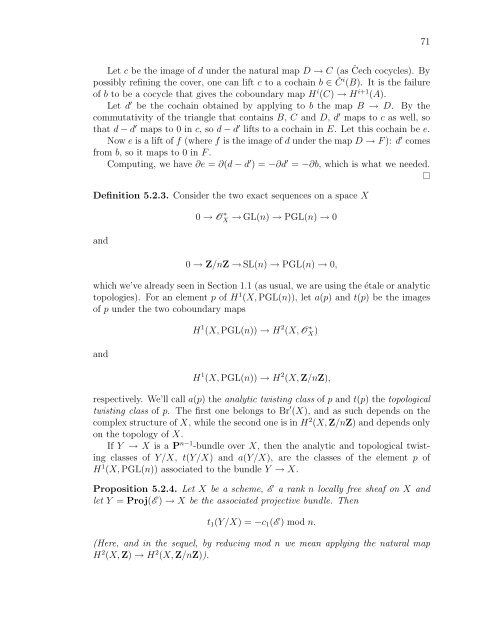derived categories of twisted sheaves on calabi-yau manifolds
derived categories of twisted sheaves on calabi-yau manifolds
derived categories of twisted sheaves on calabi-yau manifolds
You also want an ePaper? Increase the reach of your titles
YUMPU automatically turns print PDFs into web optimized ePapers that Google loves.
Let c be the image <str<strong>on</strong>g>of</str<strong>on</strong>g> d under the natural map D → C (as Čech cocycles). By<br />
possibly refining the cover, <strong>on</strong>e can lift c to a cochain b ∈ Či (B). It is the failure<br />
<str<strong>on</strong>g>of</str<strong>on</strong>g> b to be a cocycle that gives the coboundary map H i (C) → H i+1 (A).<br />
Let d ′ be the cochain obtained by applying to b the map B → D. By the<br />
commutativity <str<strong>on</strong>g>of</str<strong>on</strong>g> the triangle that c<strong>on</strong>tains B, C and D, d ′ maps to c as well, so<br />
that d − d ′ maps to 0 in c, so d − d ′ lifts to a cochain in E. Let this cochain be e.<br />
Now e is a lift <str<strong>on</strong>g>of</str<strong>on</strong>g> f (where f is the image <str<strong>on</strong>g>of</str<strong>on</strong>g> d under the map D → F ): d ′ comes<br />
from b, so it maps to 0 in F .<br />
Computing, we have ∂e = ∂(d − d ′ ) = −∂d ′ = −∂b, which is what we needed.<br />
Definiti<strong>on</strong> 5.2.3. C<strong>on</strong>sider the two exact sequences <strong>on</strong> a space X<br />
and<br />
0 → O ∗ X → GL(n) → PGL(n) → 0<br />
0 → Z/nZ → SL(n) → PGL(n) → 0,<br />
which we’ve already seen in Secti<strong>on</strong> 1.1 (as usual, we are using the étale or analytic<br />
topologies). For an element p <str<strong>on</strong>g>of</str<strong>on</strong>g> H 1 (X, PGL(n)), let a(p) and t(p) be the images<br />
<str<strong>on</strong>g>of</str<strong>on</strong>g> p under the two coboundary maps<br />
and<br />
H 1 (X, PGL(n)) → H 2 (X, O ∗ X)<br />
H 1 (X, PGL(n)) → H 2 (X, Z/nZ),<br />
respectively. We’ll call a(p) the analytic twisting class <str<strong>on</strong>g>of</str<strong>on</strong>g> p and t(p) the topological<br />
twisting class <str<strong>on</strong>g>of</str<strong>on</strong>g> p. The first <strong>on</strong>e bel<strong>on</strong>gs to Br ′ (X), and as such depends <strong>on</strong> the<br />
complex structure <str<strong>on</strong>g>of</str<strong>on</strong>g> X, while the sec<strong>on</strong>d <strong>on</strong>e is in H 2 (X, Z/nZ) and depends <strong>on</strong>ly<br />
<strong>on</strong> the topology <str<strong>on</strong>g>of</str<strong>on</strong>g> X.<br />
If Y → X is a P n−1 -bundle over X, then the analytic and topological twisting<br />
classes <str<strong>on</strong>g>of</str<strong>on</strong>g> Y/X, t(Y/X) and a(Y/X), are the classes <str<strong>on</strong>g>of</str<strong>on</strong>g> the element p <str<strong>on</strong>g>of</str<strong>on</strong>g><br />
H 1 (X, PGL(n)) associated to the bundle Y → X.<br />
Propositi<strong>on</strong> 5.2.4. Let X be a scheme, E a rank n locally free sheaf <strong>on</strong> X and<br />
let Y = Proj(E ) → X be the associated projective bundle. Then<br />
t1(Y/X) = −c1(E ) mod n.<br />
(Here, and in the sequel, by reducing mod n we mean applying the natural map<br />
H 2 (X, Z) → H 2 (X, Z/nZ)).<br />
71
















